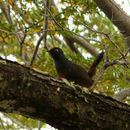Biology
provided by Arkive
A mainly ground-dwelling bird, the black-throated huet-huet forages slowly along the forest floor, pausing from time to time to scrape the ground with one foot, or to flip over pieces of debris with its bill. Occasionally it will emerge from the undergrowth to feed in the semi-open, but is always close to cover (2) (5). Although insects form an important component of its diet, it will also feed on some berries and seeds (5).
Egg laying takes place in November and December, with the average clutch size being two eggs. The nest is made from soft grass worked into a open cup, and may be positioned at the end of a burrow dug into a bank, under the roots of a fallen tree, or occasionally high up in a hollow tree (5).
Conservation
provided by Arkive
There are currently no known conservation measures in place for the black-throated huet-huet, but much of its range is protected within national parks in both Chile and Argentina (5).
Description
provided by Arkive
Secretive and inconspicuous in its dense forest habitat, the black-throated huet-huet is most readily identified by its distinctive calls, at times sounding like the yelp of a small dog (2) (3) (4). The plumage of this species is largely slaty-black, with prominent patches of rufous-chestnut on the crown, rump and lower breast, and buff barring across the belly and flanks. The brown eyes are surrounded by a conspicuous ring of bare yellowish flesh, while the bill and legs are completely black (2) (5). Juveniles are black all over, with some chestnut speckling, particularly on the crown (5). Although similar in appearance to the chestnut-throated huet-huet, with which it was formerly considered conspecific, the two species are geographically separated by more than 200 kilometres and have substantially different calls (2) (5).
Habitat
provided by Arkive
Found mainly from sea level to 1,000 metres, in dense and humid Nothofagus-dominated forests, but also in secondary forest, forest edges, bamboo thickets, and hedgerows (2) (5).
Range
provided by Arkive
The black-throated huet-huet occurs in southern Chile and southern Argentina (2).
Status
provided by Arkive
Classified as Least Concern (LC) on the IUCN Red List (1).
Threats
provided by Arkive
There are no major threats to the black-throated huet-huet, and in parts of its range it is considered to be relatively abundant (5) (6). Nonetheless, much of this species range occurs within the Chilean Temperate Forests EBA (Endemic Bird Area), an area threatened by intensive logging and timber plantations (7). Furthermore this species is known to decline rapidly in response to habitat fragmentation (5).
Black-throated huet-huet
provided by wikipedia EN
- license
- cc-by-sa-3.0
- copyright
- Wikipedia authors and editors
Black-throated huet-huet: Brief Summary
provided by wikipedia EN
The black-throated huet-huet Spanish pronunciation: [wet wet], (Pteroptochos tarnii) is a species of bird in the family Rhinocryptidae. It is found in southern/central Chile and adjacent western Argentina. Its natural habitat is temperate forest.

Chiloe National Park near Cucao, Chile
- license
- cc-by-sa-3.0
- copyright
- Wikipedia authors and editors


